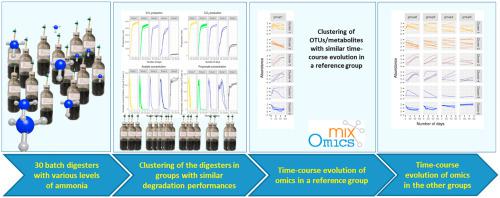Chemosphere ( IF 8.1 ) Pub Date : 2021-06-22 , DOI: 10.1016/j.chemosphere.2021.131309 Olivier Chapleur 1 , Simon Poirier 1 , Angéline Guenne 1 , Kim-Anh Lê Cao 2

|
Omics longitudinal studies are effective experimental designs to inform on the stability and dynamics of microbial communities in response to perturbations, but time-course analytical frameworks are required to fully exploit the temporal information acquired in this context. In this study we investigate the influence of ammonia on the stability of anaerobic digestion (AD) microbiome with a new statistical framework. Ammonia can severely reduce AD performance. Understanding how it affects microbial communities development and the degradation progress is a key operational issue to propose more stable processes. Thirty batch digesters were set-up with different levels of ammonia. Microbial community structure and metabolomic profiles were monitored with 16 S-metabarcoding and GCMS (gas-chromatography-mass-spectrometry). Digesters were first grouped according to similar degradation performances. Within each group, time profiles of OTUs and metabolites were modelled, then clustered into similar time trajectories, evidencing for example a syntrophic interaction between Syntrophomonas and Methanoculleus that was maintained up to 387 mg FAN/L. Metabolites resulting from organic matter fermentation, such as dehydroabietic or phytanic acid, decreased with increasing ammonia levels. Our analytical framework enabled to fully account for time variability and integrate this parameter in data analysis.
中文翻译:

暴露于氨的厌氧消化器中代谢组学和微生物反应的时程分析
组学纵向研究是有效的实验设计,可以了解微生物群落响应扰动的稳定性和动态,但需要时间过程分析框架来充分利用在这种情况下获得的时间信息。在这项研究中,我们使用新的统计框架研究了氨对厌氧消化 (AD) 微生物组稳定性的影响。氨会严重降低 AD 性能。了解它如何影响微生物群落的发展和降解过程是提出更稳定过程的关键操作问题。用不同水平的氨设置了 30 个间歇式消化器。用 16 S-metabarcoding 和 GCMS(气相色谱-质谱)监测微生物群落结构和代谢组学特征。首先根据相似的降解性能对消化器进行分组。在每组中,对 OTU 和代谢物的时间曲线进行建模,然后将其聚类为相似的时间轨迹,例如证明Syntrophomonas和Methanoculleus维持在高达 387 mg FAN/L。有机物发酵产生的代谢物,如脱氢枞酸或植烷酸,随着氨含量的增加而减少。我们的分析框架能够充分考虑时间可变性并将此参数集成到数据分析中。











































 京公网安备 11010802027423号
京公网安备 11010802027423号